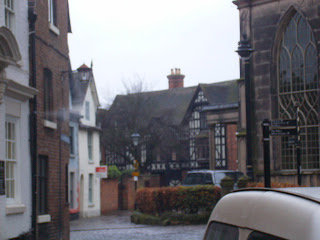There were known to be at least 4 church's by the year 1066 which is of course when William the Conqueror claimed the British Isles. The first Earl of Shrewsbury was Roger de Montgomery he started to build a castle in 1074 in the same location where Shrewsbury Castle stands today. Further along in this blog will be some pictures of the castle and the surrounding building. I was quite astonished that Shrewsbury Prison was so close, in New Zealand a lot of prisons are a good distance from the towns and cities.
In 1218 the town received a grant, this was to build the first ever town walls in England. Shrewsbury also received one of the earliest grants of pavage in 1266 so that the new market place could be paved.
Shrewsbury is 9 miles from the Welsh boarder, however in 1215 and 1234 Llywelyn the Great led Welsh forces against the town, due to this the defences were increased. There was a parliament held in Shrewsbury in 1238 by Edward I, this Parliament was the first to include a House of Commons. The Parliament was set up so that Dafydd ap Gruffydd (who was the last free ruler of Wales) fate could be decided. I have no knowledge of his trial however it is said that Dafydd was executed, in those days it meant he was hanged, drawn and quartered, Dafydd was accused of High Treason. So now you know the last Welsh ruler was pout to death in Shrewsbury.
Shrewsbury is a town that is mainly known for its Woollen trade, the woollen cloth was sent to London to be sold. Nothing much changed until the railways were introduced. I didn't get time to visit the churches in Shrewsbury, however there were plenty of them as you will see in the following photos
This is the coat of Arms that is on the Old Market Hall
Today the Old market Hall holds a lovely Café and a Cinema
Inside the Café you can see the workings for the clock
The building is magnificent and I wonder if this was once the front of the building
This is a photo of one of the many Tudor buildings, this is viewed from the Old Market Hall.
How is this for a Information Centre!!
This is the back of Shrewsbury Castle and the most elegant Railway Station.
Looking down on the Railway Station from a walkway around the bottom of the Castle
Shrewsbury Library. There is a statue just above the green hedge, I have a feeling this is Charles Darwin who was born in Shrewsbury. Another bit of history I didn't know.
This three story Tudor building looks like it is been renovated, it stands just outside the castle gates.
A view towards the castle entrance.
Through the gates
From 1926 - 1981 the Castle was used as the Council Chambers for the local government
This Castle has been used to house the Shropshire Regiment Museum since 1985, it is wonderful to look around, I was amazed at how many years of the Regiment that is covered.
This is a map of a Battle that took place in France in 1916, the map shows where many brave men died and now lay buried, many of those were of course from the Shropshire Regiment, this includes Private John James Keay who lost his life on the 18th July 1916. This young man is related to Tina.
One of the helpful gentleman who explained to Tina where and how the battle was fought and why there was no bodies recovered. Just at the top of this photograph you can see another document, this is a memorial with details of Private John James Keay.
This photo shows the uniforms of an Officer and a Private in World War I from the Shropshire Regiment.
Anyway those where the important ones that I thought you would enjoy looking at. The next photos mainly of the old Tudor buildings that abound along with some of the churches. I had thought that my home town of Sandbach had plenty of Tudor building, however these were around nearly every corner.
Looks like the buildings are about to fall over, how they have managed to stand for so long shows how great the craftsman of the day were.
Fish Street
Beside and below the church
Notice the cobbled roadway
Groupers Lane
This church is very close to the one that is shown earlier
A view down the road from the walkway around the bottom of the Castle. Apparently there is a penny arcade somewhere along there.
This is a side view of the three story Tudor house outside the Castle gate.
Of course there were Georgian Houses too
I cant remember the name of this Manor, however it is hired out for various things
This is a view from the Manor to the road
I really need to read the plaque above the stone again, apparently it is a stone that came down in the Ice Age.
Well it was a wonderful day though rather soggy as the day progressed, this is also the main reason why the photos look dark, all the walking has made us both tired, i tmay just be an early night this time. Enjoy and take care x







































No comments:
Post a Comment